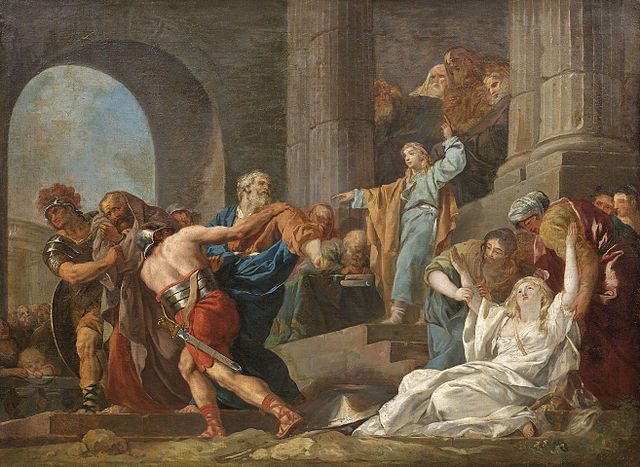
Word of the Day: Apocrypha
Today’s word of the day, partly thanks to the Grandiloquent Word of the Day (https://www.grandiloquentwordoftheday.com/), is apocrypha. In English, historically, the word is initially a proper noun, Apocrypha, but the meaning was later generalized. Dictionary.com provides three definitions:
- (initial capital letter) a group of 14 books, not considered canonical, included in the Septuagint and the Vulgate as part of the Old Testament, but usually omitted from Protestant editions of the Bible.
- various religious writings of uncertain origin regarded by some as inspired, but rejected by most authorities.
- writings, statements, etc., of doubtful authorship or authenticity
Etymonline explains further: “late 14c., Apocrifa, ‘the apocryphal books of the Bible,’ from Late Latin apocrypha (scripta), from neuter plural of apocryphus ‘secret, not approved for public reading,’ from Greek apokryphos ‘hidden; obscure, hard to understand,’ thus ‘(books) of unknown authorship’ (especially those included in Septuagint and Vulgate but not originally written in Hebrew and not counted as genuine by the Jews), from apo ‘off, away’ (see apo-) + kryptein ‘to hide’ (see crypt).
“The non-Biblical sense of ‘writing of doubtful authorship or authenticity’ is from 1735. Properly plural (the single would be Apocryphon or apocryphum), but commonly treated as a collective singular” (https://www.etymonline.com/search?q=apocrypha).
On this date in 1564, Pope Pius IV issued the Benedictus Deus. This papal bull confirmed the various decisions made by the Council of Trent, which met in the city of Trent (or Trento) at various times between December of 1545 and December of 1563. There were 25 meetings in all, and the council was convened in order to respond to the Protestant Reformation. Trent was, at the time, part of the Austro-Hungarian Empire, but today it is in northern Italy.
The background of the Council of Trent is interesting. The Roman Catholic Church had experienced the Great Schism from 1378 to 1417, a period during which there were competing popes claiming the ultimate authority. The schism ended with the Council of Constance, which asserted that councils were superior to popes, and which encouraged the church to have regular councils. From that point on, popes, and even cardinals in the Church, didn’t want to convene councils. So the Council of Trent was the first council for over 100 years despite the fact that some in the church, including Martin Luther, wanted the Church to convene councils.
Pope Paul III convened the Council of Trent despite opposition from most of the cardinals. The Reformation, which had started with only a few proponents, had grown particularly in norther Europe, and Pope Paul III wanted to assert the authority of the Roman church again. At one point, the Council even invited some well-known Protestants to join the Council, but the Protestants were not going to be allowed to vote on any final product, so their cooperation was limited.
One of the decisions made by the Council of Trent was keeping the deuterocanonical works in the Roman Catholic Bible. Deuterocanonical comes from Greek and means, basically, belong to the second canon. These books are Tobit, Judith, Baruch, Sirach (or Ecclesiasticus), 1 Maccabees, 2 Maccabees, and Wisdom, along with additions to Esther (chapter 10 through 16), additions to Daniel (much of chapter 3 and chapters 13 and 14, and additions to Baruch (chapter 6). The Eastern Orthodox Church includes all of those in its Bible along with the Prayer of Manasseh, 1 Esdras, 2 Esdras, 3 Maccabees, 4 Maccabees as an appendix, and Psalm 151.
Martin Luther, in his version of the Bible, included these books between the Old and New Testaments and called them the Apocrypha, saying that while they do not have the same authority as the canon they are still good books and worth reading.
One of my favorite stories from the Apocrypha is the story of Susanna and the Elders (chapter 13 of the Book of Daniel in the Roman Catholic Bible), which may be one of the oldest detective stories in the world. Susanna is a beautiful young wife who gets the (creepy) notice of two of the village elders. When she refuses their advances, they accuse of her of adultery with a mysterious young man, saying that they saw the two making love under a tree in the garden. The village is about to stone Susanna to death, as per Jewish law, when Daniel arrives in the village. After an inquiry, Daniel asks to speak to the two elders individually, separating them. He asks each one what kind of tree the couple were discovered under. The answers, of course, are different, and Susanna is saved.
The image today is a painting of the story of Susanna and the Elders, “Attributed to François-Guillaume Méneageot [1744-1816] circa 1779” (https://www.thetorah.com/article/the-tale-of-susanna-a-story-about-daniel).